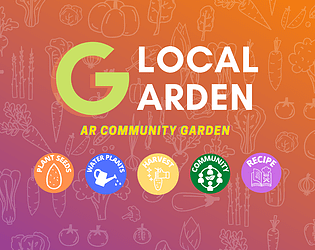Play Prototype
Glocal Garden's itch.io pageSummary of Approach
We built a community garden for young people to help them learn about nature, climate change and other cultures by cultivating a community garden.
Subject-Matter/Problem Background
Climate change is a global crisis that is upsetting all aspects of our lives. The scientific literature consistently points to the following causes:
- Disconnection from the natural environment
- Decreased capacity to care for each other (empathy)
- Diminished sense of belonging to something bigger than ourselves (sense of community)
This matters because the survival of our species depends on our ability to overcome current global challenges, climate change being on them.
XR Platform
Smart Phone
Project Presentation
https://docs.google.com/presentation/d/1ORVgk0kb-bnI_wtuc3aYyzuQuvOx8KW5zVZCMOJlZEo/edit#slide=id.ge0b145d6bb_0_70
Research or Subject-Matter References
Guiding concepts
Human beings have gradually distanced themselves from nature as a result of complex social and economic forces (Louv, 2005)
Human beings have an innate tendency to love nature (“biophilia hypothesis”, Wilson, 1984)
The relation between young people with their natural environment: children are socialized to be scared of nature and risky play (Louv, 2005; Brussoni, Olsen, Pike, & Sleet, 2012) and this has a negative impact on child development (Louv, 2005; Herrington & Nicholls, 2007).
Technology has a role to play in increasing nature connection and conservation behaviours, if used properly (Truong & Clayton, 2020, Thomas, 2013)
Today’s children are socialized to be fearful of nature. Mobile apps can help children feel safe and encourage exploration by helping them identify what plants are safe to touch (NWF Report)
Most technology-mediated experiences of nature are not as effective in promoting physical and mental health in children as ‘true’ experiences in/with nature (Chowla, 2020); however, high quality apps can be used as a stepping stone towards a renewed interest in young people for being in/with nature (Thomas, 2013).
References
Brussoni, M., Olsen, L.L., Pike, I., & Sleet, D.A. (2021). Risky play and children’s safety: balancing priorities for optimal child development. International Journal of Environmental Research and Public Health, 9, 3134-3148.
Chowla, L. (2020). Childhood nature connection and constructive hope: a review of research on connecting with nature and coping with environmental loss. People and Nature, 2, 619-642.
Coyle, K. J. (2017). Digital technology’s role in connecting children and adults to nature and the outdoors. National Wildlife Federation.
Herrington, S. & Nicholls, J. (2007). Outdoor play spaces in Canada: the safety dance of standards as policy. Critical Social Policy, 27, 128-138.
Louv, R. (2005). The last child in the woods: saving our children from nature-deficit disorder. Algonquin books of Chapel HIll.
Thomas, S. (2013). Technobiophilia: Nature and Cyberspace. Bloomsbury: New York.
Truong, M. A., & Clayton, S. (2020). Technologically transformed experiences of nature: a challenge for environmental conservation? Biological Conservation, 244, 108522.
Wilson, E.O. (1984). Biophilia. Harvard University ed., Cambridge.
Full Credits for all of the Team Members and Contributors
Bryan Zhang -Co-Producer & Developer
Joanna Liu - Co-Producer, Developer, Designer
Monica Paprocki - Co-Producer & Designer
Stefania Maggi - Subject Matter Expert
Sebastiano Pocchi - Subject Matter Expert
Puneet Bhargava - Developer
Leave a comment
Log in with itch.io to leave a comment.








Comments
No one has posted a comment yet